It's been almost two weeks since I last posted on here. Although I haven't been traveling anywhere, I've been incredibly busy with work. Since my last post, my father had actually come back to Belgium on a business trip. After work all of last week, we went out to some restaurants and as a result, I didn't get back to my flat until pretty late at night. At that point, I didn't have time to update my blog.
I'm still in Belgium wrapping things up. Tomorrow is my last day here at IMEC. I actually need to start making a presentation for tomorrow, so I'll end this post here. To whoever reads this blog, no worries, I'm still alive!
This blog is dedicated to my adventures and experiences traveling around Europe and performing research with the Interuniversity Microelectronics Center (IMEC) through JHU's Institute for NanoBiotechnology's (INBT) IRES program (http://inbt.jhu.edu/)
Tuesday, August 25, 2009
Thursday, August 13, 2009
Post-London
After visiting London, I spent the next two weekends just relaxing around Belgium and visiting some nearby cities. Both weekends I ended up going back to IMEC to work on a couple things. Even though I'm over here in Belgium, I'm still able to work on some things for my research back at Hopkins like editing figures and drafts for papers we're in the process of submitting and publishing.
My time here at IMEC is winding down far too quickly. Even with an entire summer over here, it's not enough time complete a project. No matter what type of facilities you have, finishing a project in 3 months is incredibly difficult. Originally, INBT's IRES program was slated to last between 8-10 weeks for undergrads. I can't imagine being limited to such a short time span. It took me at least 3-4 weeks just to get situated and trained on the basic instruments. I waited 2 weeks just to get trained for general clean room use.
I think I forgot to mention the differences between university research and industrial research. Transitioning into university research is significantly more fast paced than in industry. At the university setting, your research groups are generally small and it's much more personal. You can use almost any instrument as long as you receive training. Training itself is generally easy to obtain. Simply ask someone to show you how to use the instrument. At large companies, there's always paperwork involved and training sessions to be scheduled weeks in advance. This is all for liability purposes. If you make a mistake, there is a lot on the line for the company, including its reputation and your own personal safety. As a result, in order to limit liability, companies have formalities that must be followed to the dot.
My last internship at ExxonMobil was exactly the same. In order to use certain solvents, I had to file paperwork and then wait for it to be processed. Specifically, I wasn't allowed to use chloroform until I had the correct paperwork filed. It's an annoying inconvenience, but for large corporations it's a necessity. IMEC, however, isn't as strict as ExxonMobil. I've used HF without ever having to sign a document beforehand.
I've already mentioned before that technicians operate a lot of the instruments here, including thermal evaporators, select sputter systems, select plasma etchers, e-beams, and a large majority of the expensive instruments. Before being allowed to use some of the instruments, I had to verify my fabrication process with some of the technicians. I had to discuss with them the composition of my samples and why I needed to use certain instruments. It took me almost 3 weeks to get approval to use a plasma etcher. At one point, I almost wasn't allowed to use the etcher at all because the technician feared that my sample might ruin the instrument. After some convincing, I was luckily allowed access to the instrument. My point here is that in industry, your research goes by much slower than in a university setting. Sometimes I'll wait 3 days to run my samples through a single process. If I was back at Hopkins, I could have it done in less than half an hour.
The most noticeable difference between research at the university and in industry is the pace at which it progresses. Although it may not be desirable, you just have to acclimate to the change in pace.
My time here at IMEC is winding down far too quickly. Even with an entire summer over here, it's not enough time complete a project. No matter what type of facilities you have, finishing a project in 3 months is incredibly difficult. Originally, INBT's IRES program was slated to last between 8-10 weeks for undergrads. I can't imagine being limited to such a short time span. It took me at least 3-4 weeks just to get situated and trained on the basic instruments. I waited 2 weeks just to get trained for general clean room use.
I think I forgot to mention the differences between university research and industrial research. Transitioning into university research is significantly more fast paced than in industry. At the university setting, your research groups are generally small and it's much more personal. You can use almost any instrument as long as you receive training. Training itself is generally easy to obtain. Simply ask someone to show you how to use the instrument. At large companies, there's always paperwork involved and training sessions to be scheduled weeks in advance. This is all for liability purposes. If you make a mistake, there is a lot on the line for the company, including its reputation and your own personal safety. As a result, in order to limit liability, companies have formalities that must be followed to the dot.
My last internship at ExxonMobil was exactly the same. In order to use certain solvents, I had to file paperwork and then wait for it to be processed. Specifically, I wasn't allowed to use chloroform until I had the correct paperwork filed. It's an annoying inconvenience, but for large corporations it's a necessity. IMEC, however, isn't as strict as ExxonMobil. I've used HF without ever having to sign a document beforehand.
I've already mentioned before that technicians operate a lot of the instruments here, including thermal evaporators, select sputter systems, select plasma etchers, e-beams, and a large majority of the expensive instruments. Before being allowed to use some of the instruments, I had to verify my fabrication process with some of the technicians. I had to discuss with them the composition of my samples and why I needed to use certain instruments. It took me almost 3 weeks to get approval to use a plasma etcher. At one point, I almost wasn't allowed to use the etcher at all because the technician feared that my sample might ruin the instrument. After some convincing, I was luckily allowed access to the instrument. My point here is that in industry, your research goes by much slower than in a university setting. Sometimes I'll wait 3 days to run my samples through a single process. If I was back at Hopkins, I could have it done in less than half an hour.
The most noticeable difference between research at the university and in industry is the pace at which it progresses. Although it may not be desirable, you just have to acclimate to the change in pace.
Tuesday, August 11, 2009
London Part 3
I still have quite a bit to discuss about London. Picking up from where I left off, on my last day in London I first stopped by Westminster Abbey.


I was a little surprised about how pricey admission into the cathedral was. There were no student discounts, so the full fare was 15 British pounds (~$25). Although an audio listening device was provided at no additional cost, it was still rather expensive.
Inside the abbey is a coronation chair where all English and British monarchs sit when they're being crowned. It's been used at every coronation since 1308. I couldn't take pictures inside, so I won't be able to show images.
The Abbey is also the location of many burial sites. On the ground inside the Abbey, there are slabs the size of coffins that acknowledge the body of the person lying below. Several historical figures that are buried here include Charles Dickens, Jane Austin, Sir Isaac Newton, and Charles Darwin.
London's Tomb of the Unknown Solider is also located in Westminster Abbey.
After visiting the Abbey, I made my way to the British Museum.
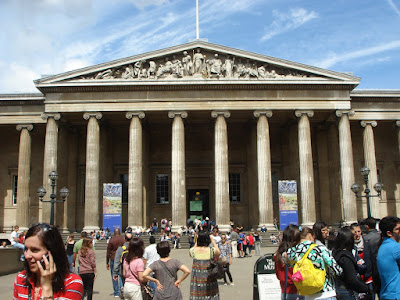
This museum is essentially a miniaturized version of the Louvre in Paris. It contains a hodgepodge of antiquities ranging from ancient Egypt, Greece, Asia, Africa, and the Americas. The most spectacular piece in their collection is the Rosetta Stone.

The crowd gathered around the Rosetta Stone reminded me of the crowd around the Mona Lisa in Paris. An arc of people surround the perimeter and all were trying to take snapshots. I think part of the reason for the large crowd stems from the fact that the Rosetta Stone is placed in the first room you run into after gaining admission into the museum. It is the museum's highlight, so I guess it makes sense for it to be at the forefront.
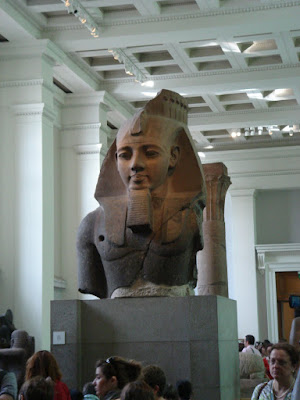
In the Egyptian exhibit there's a huge bust of Ramses II. There were also the obligatory mummies on display as well.

In the Greece exhibit, remnants of the Parthenon were on display.
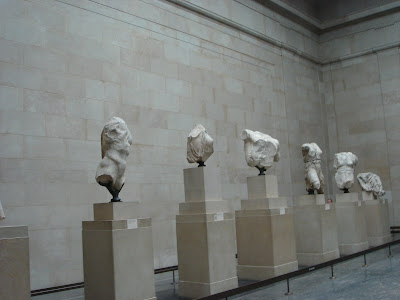
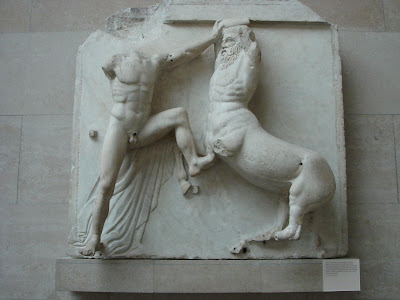
After wandering into the Asian antiquities section I found this little guy.

For some reason, this guy reminds me of the Power Rangers. I feel like this monkey just morphed into his combat costume or something. Either that or he's a well-fashioned zord (most likely belonging to the yellow ranger). However, I think the Sabre-Toothed Tiger is more intimidating than this little guy. Unibrows are not intimidating. Okay, enough of the Power Rangers flashback. Onwards we go.
After leaving the the Asian antiquities exhibit, I kind of got lost and I randomly starting walking around the museum. Somehow I ended up in an exhibit featuring the oldest known chess set. It was discovered in 1831 and is carved out of walrus teeth.

I also found this violin-like instrument on display.
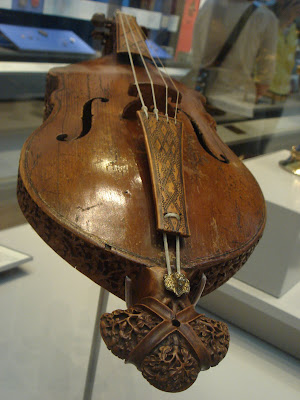
It supposedly dates back to 1300. The side view of this instrument I found to be much more interesting.
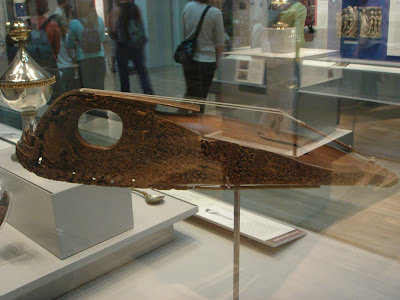
The British Museum had plenty more exhibits and antiquities, however, I'm only mentioning here the main highlights.
After walking around the museum for a couple hours, I decided to find somewhere to go for dinner. I stumbled into a restaurant called the Criterion. I found it from my guidebook, but it didn't mention that the place was classy. I came in horribly under dressed, wearing jeans and birkenstocks. They didn't refuse at the door though, so I just sat down and decided to have my dinner there.

For my appetizer, I got king scallops with shrimp.

Unfortunately, the scallops weren't very king size.
And for my main course I got ostrich fillets! It was the oddest thing that I saw on the menu, so I obviously just had to try it. Not even Asians eat ostrich, so I guess English cuisine is pretty daring, or probably just more sophisticated. Yeah, I'll go with more classy/sophisticated.

After I ordered the ostrich, the waitress asked me how I would like it cooked. Maybe I'm gullible, but I just glaringly stared at her, confused for a little bit, because I didn't know what my options were. Apparently it's just like ordering steak, so I ordered medium. The taste of the meat was a mix between lamb and beef. In addition, the color of the meat was very dark. By looking at it, I could barely tell it was medium. I was only able to notice after taking a bite and noticing the texture. Overall it was an interesting experience. I enjoyed the taste and if given the chance to order it again, I think I would.
Anyway, this dinner concluded my trip to London. Right after this I had to go back to the hostel to retrieve my things and then head back home to Leuven.
I thoroughly enjoyed my time in this magnificent city. Even after 4 days, I didn't get close to seeing as much as I had hoped. Perhaps there will be a next time...
I was a little surprised about how pricey admission into the cathedral was. There were no student discounts, so the full fare was 15 British pounds (~$25). Although an audio listening device was provided at no additional cost, it was still rather expensive.
Inside the abbey is a coronation chair where all English and British monarchs sit when they're being crowned. It's been used at every coronation since 1308. I couldn't take pictures inside, so I won't be able to show images.
The Abbey is also the location of many burial sites. On the ground inside the Abbey, there are slabs the size of coffins that acknowledge the body of the person lying below. Several historical figures that are buried here include Charles Dickens, Jane Austin, Sir Isaac Newton, and Charles Darwin.
London's Tomb of the Unknown Solider is also located in Westminster Abbey.
After visiting the Abbey, I made my way to the British Museum.
This museum is essentially a miniaturized version of the Louvre in Paris. It contains a hodgepodge of antiquities ranging from ancient Egypt, Greece, Asia, Africa, and the Americas. The most spectacular piece in their collection is the Rosetta Stone.
The crowd gathered around the Rosetta Stone reminded me of the crowd around the Mona Lisa in Paris. An arc of people surround the perimeter and all were trying to take snapshots. I think part of the reason for the large crowd stems from the fact that the Rosetta Stone is placed in the first room you run into after gaining admission into the museum. It is the museum's highlight, so I guess it makes sense for it to be at the forefront.
In the Egyptian exhibit there's a huge bust of Ramses II. There were also the obligatory mummies on display as well.
In the Greece exhibit, remnants of the Parthenon were on display.
After wandering into the Asian antiquities section I found this little guy.
For some reason, this guy reminds me of the Power Rangers. I feel like this monkey just morphed into his combat costume or something. Either that or he's a well-fashioned zord (most likely belonging to the yellow ranger). However, I think the Sabre-Toothed Tiger is more intimidating than this little guy. Unibrows are not intimidating. Okay, enough of the Power Rangers flashback. Onwards we go.
After leaving the the Asian antiquities exhibit, I kind of got lost and I randomly starting walking around the museum. Somehow I ended up in an exhibit featuring the oldest known chess set. It was discovered in 1831 and is carved out of walrus teeth.
I also found this violin-like instrument on display.
It supposedly dates back to 1300. The side view of this instrument I found to be much more interesting.
The British Museum had plenty more exhibits and antiquities, however, I'm only mentioning here the main highlights.
After walking around the museum for a couple hours, I decided to find somewhere to go for dinner. I stumbled into a restaurant called the Criterion. I found it from my guidebook, but it didn't mention that the place was classy. I came in horribly under dressed, wearing jeans and birkenstocks. They didn't refuse at the door though, so I just sat down and decided to have my dinner there.
For my appetizer, I got king scallops with shrimp.
Unfortunately, the scallops weren't very king size.
And for my main course I got ostrich fillets! It was the oddest thing that I saw on the menu, so I obviously just had to try it. Not even Asians eat ostrich, so I guess English cuisine is pretty daring, or probably just more sophisticated. Yeah, I'll go with more classy/sophisticated.
After I ordered the ostrich, the waitress asked me how I would like it cooked. Maybe I'm gullible, but I just glaringly stared at her, confused for a little bit, because I didn't know what my options were. Apparently it's just like ordering steak, so I ordered medium. The taste of the meat was a mix between lamb and beef. In addition, the color of the meat was very dark. By looking at it, I could barely tell it was medium. I was only able to notice after taking a bite and noticing the texture. Overall it was an interesting experience. I enjoyed the taste and if given the chance to order it again, I think I would.
Anyway, this dinner concluded my trip to London. Right after this I had to go back to the hostel to retrieve my things and then head back home to Leuven.
I thoroughly enjoyed my time in this magnificent city. Even after 4 days, I didn't get close to seeing as much as I had hoped. Perhaps there will be a next time...
Monday, August 10, 2009
IMEC Update 8/10/09
As my time here is winding down, I'm scrambling to get in as much work as I possibly can. From today, I have a little more than 2 weeks left here in Belgium. All good things must come to an end, there are no exceptions.
So what have I been up to at IMEC? Almost all the work that I do is inside the clean room. All day I go in and out, changing into the clean room suits probably more than 5 times a day. Every instrument involved in lithographic fabrication is inside one of the many sections of the clean room here, including thermal evaporators, sputter systems, ion-milling systems, electron beam evaporators, profilometers and ellipsometers, solvent/acid wet benches, plasma etchers, dicing tools, optical microscopes, spin-coaters, mask aligners (3 in a single room capable of handling 8" wafers. They have more than 3 mask aligners here. These 3 are just the ones that I have access to.) and numerous other instruments used for functions that I'm not aware of.
As I've mentioned months earlier, the most annoying part about research here at IMEC is still the fact that technicians operate most the instruments. Yes, I'm thankful that it's less work for me since I don't have to run the instrument, however, sometimes I'll wait a day or 2 for my sample to be processed. Although I have enough work to do to keep me busy in the mean time, sometimes the samples that I need processed are the ones that I desperately need the most. The worst offending instrument is the e-beam (electron beam instrument used for lithography).
There are multiple different forms of lithography. Two such types include photolithography and electron beam lithography. The advantage of e-beam lithography over photolithography is the resolution that you're able to achieve. Electron beam lithography is used to pattern nanoscale structures while photolithography is conventionally used to pattern microscale structures. In an earlier post I tried to describe the basics of lithography. First you start with a bare silicon wafer, spin coat a resist material onto the wafer, and then pattern something into the resist using, in these cases, photolithography or e-beam lithography. In photolithography, UV light is exposed to certain areas of the wafer using a mask to block the UV light from penetrating other areas of the wafer. If a positive resist is spin-coated onto the wafer, then once it's placed in a developing solution, those areas exposed to UV light will be etched away. With a negative resist, the opposite occurs such that areas NOT exposed to UV become etched.
Here at IMEC, I'm using electron beam lithography. Instead of using UV light to pattern my samples, an electron beam scans across the areas defined in my mask. . This is probably the most important step in the process because it creates your pattern. Without any patterns you don't have any structures. After being exposed to the e-beam, the patterns are developed similarly to photolithography, however a different solution is used as the developer.
The e-beam is the bottleneck that's holding back my research. It's a very delicate and expensive instrument, so a technician operates it. There are numerous research teams here at IMEC and a lot of people require the use of the instrument. As a result, each group is technically only allowed to use the instrument once every seven days. For my structures, I require two steps of e-beam lithography, so that already sets me back 2 weeks to process one batch of samples. For the past couple weeks, the technician has been on vacation and will continue to be on vacation until after I leave Belgium. Two people in the group I work in are trained on the instrument, however their use of it is limited. They've also been taking vacations on and off, so it's tough to catch them, let alone ask them to do extra work for you. Everyone here is very friendly though, so they're always willing to do the work for you. You just may have to wait a couple extra days when they're not on vacation or busy with their own projects.
Currently, I'm still in the fabrication stage of my structures. I'm in and out of the clean room fabricating them and then occasionally taking images with a scanning electron microscope. In the next couple days I'll be changing my routine as I begin to take optical measurements of my samples. I think I said that in my last post, but I'm hoping that if I keep saying it then it'll actually happen.
I'll end with a couple more random observations:
-With reference to the cost of something, in the number system Europeans use a comma to separate the equivalent of dollars and cents. I'm actually not quite sure what they call the equivalent of the American cent. If I go to the store and buy something for 5,50, the cashier says that it cost five euro fifty.
-The cost to use the facilities at the laundromat are significantly more expensive than Hopkins. One load of laundry (in a washing machine half the size of what you see at the campus facilities) costs a whopping 3.80 euros. I forgot what I paid to use the dryer. The cost is per every 8 minutes and I don't remember how long I used it. I just keep refeeding the hungry meter until my clothes are dry.
-When I was in Paris, I checked out a McDonalds to see what the menu looked like. A medium fries cost 2.20 euros (~$3.12)!!! I haven't been to a McDonald's in the states in probably 2 years now, but I recall it being on the dollar menu. You can also buy beer at McDonalds.
-Speaking of beer, you can usually buy it in vending machines as well (at least here in Belgium). It's the cheap kind though, so it's the equivalent of Natty Boh or Keystone Light in the states.
-Still speaking of beer, it's not illegal to walk around with an open alcoholic beverage in public.
So what have I been up to at IMEC? Almost all the work that I do is inside the clean room. All day I go in and out, changing into the clean room suits probably more than 5 times a day. Every instrument involved in lithographic fabrication is inside one of the many sections of the clean room here, including thermal evaporators, sputter systems, ion-milling systems, electron beam evaporators, profilometers and ellipsometers, solvent/acid wet benches, plasma etchers, dicing tools, optical microscopes, spin-coaters, mask aligners (3 in a single room capable of handling 8" wafers. They have more than 3 mask aligners here. These 3 are just the ones that I have access to.) and numerous other instruments used for functions that I'm not aware of.
As I've mentioned months earlier, the most annoying part about research here at IMEC is still the fact that technicians operate most the instruments. Yes, I'm thankful that it's less work for me since I don't have to run the instrument, however, sometimes I'll wait a day or 2 for my sample to be processed. Although I have enough work to do to keep me busy in the mean time, sometimes the samples that I need processed are the ones that I desperately need the most. The worst offending instrument is the e-beam (electron beam instrument used for lithography).
There are multiple different forms of lithography. Two such types include photolithography and electron beam lithography. The advantage of e-beam lithography over photolithography is the resolution that you're able to achieve. Electron beam lithography is used to pattern nanoscale structures while photolithography is conventionally used to pattern microscale structures. In an earlier post I tried to describe the basics of lithography. First you start with a bare silicon wafer, spin coat a resist material onto the wafer, and then pattern something into the resist using, in these cases, photolithography or e-beam lithography. In photolithography, UV light is exposed to certain areas of the wafer using a mask to block the UV light from penetrating other areas of the wafer. If a positive resist is spin-coated onto the wafer, then once it's placed in a developing solution, those areas exposed to UV light will be etched away. With a negative resist, the opposite occurs such that areas NOT exposed to UV become etched.
Here at IMEC, I'm using electron beam lithography. Instead of using UV light to pattern my samples, an electron beam scans across the areas defined in my mask. . This is probably the most important step in the process because it creates your pattern. Without any patterns you don't have any structures. After being exposed to the e-beam, the patterns are developed similarly to photolithography, however a different solution is used as the developer.
The e-beam is the bottleneck that's holding back my research. It's a very delicate and expensive instrument, so a technician operates it. There are numerous research teams here at IMEC and a lot of people require the use of the instrument. As a result, each group is technically only allowed to use the instrument once every seven days. For my structures, I require two steps of e-beam lithography, so that already sets me back 2 weeks to process one batch of samples. For the past couple weeks, the technician has been on vacation and will continue to be on vacation until after I leave Belgium. Two people in the group I work in are trained on the instrument, however their use of it is limited. They've also been taking vacations on and off, so it's tough to catch them, let alone ask them to do extra work for you. Everyone here is very friendly though, so they're always willing to do the work for you. You just may have to wait a couple extra days when they're not on vacation or busy with their own projects.
Currently, I'm still in the fabrication stage of my structures. I'm in and out of the clean room fabricating them and then occasionally taking images with a scanning electron microscope. In the next couple days I'll be changing my routine as I begin to take optical measurements of my samples. I think I said that in my last post, but I'm hoping that if I keep saying it then it'll actually happen.
I'll end with a couple more random observations:
-With reference to the cost of something, in the number system Europeans use a comma to separate the equivalent of dollars and cents. I'm actually not quite sure what they call the equivalent of the American cent. If I go to the store and buy something for 5,50, the cashier says that it cost five euro fifty.
-The cost to use the facilities at the laundromat are significantly more expensive than Hopkins. One load of laundry (in a washing machine half the size of what you see at the campus facilities) costs a whopping 3.80 euros. I forgot what I paid to use the dryer. The cost is per every 8 minutes and I don't remember how long I used it. I just keep refeeding the hungry meter until my clothes are dry.
-When I was in Paris, I checked out a McDonalds to see what the menu looked like. A medium fries cost 2.20 euros (~$3.12)!!! I haven't been to a McDonald's in the states in probably 2 years now, but I recall it being on the dollar menu. You can also buy beer at McDonalds.
-Speaking of beer, you can usually buy it in vending machines as well (at least here in Belgium). It's the cheap kind though, so it's the equivalent of Natty Boh or Keystone Light in the states.
-Still speaking of beer, it's not illegal to walk around with an open alcoholic beverage in public.
Friday, August 7, 2009
London again
On Sunday, I devoted most of my time to just walking around the markets and shopping areas. Early in the morning I ventured over to Covent Garden Market.

This outside area is devoted to street performers. Early in the morning it wasn't very crowded at all. The weather wasn't very cooperative either, so that may have influenced the absence of entertainers. Inside the building on the left are stalls where local businesses sell their goods, ranging from glassware, ceramics, jewelry, hats, clothes, and random knickknacks. It's essentially a glorified farmer's market, some things were rather expensive (as in >100 euros).
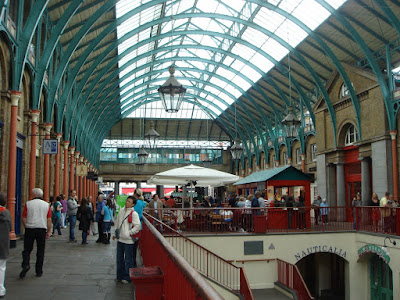

Eventually I made my way to two of the most popular shopping streets in all of London. The picture above is on Regent street. This street is filled with fancy shops and upscale department stores. It also had the biggest Apple store I've ever seen. I forgot to take a picture of it unfortunately, but it was two stories with about 80% of the store empty with only small tables along the perimeter. Fairly typical of any other Apple store, lots of wasted space.
The picture below was taken on Oxford street. It's a road practically 1 mile long filled with stores and department stores on either side. Unlike Regent street, the stores along this area were much more affordable.

I honestly spent almost the entire day just shopping around and I don't have very many pictures chronicling my shopping spree.
Fast forward a couple hours, I went back to the south eastern part of London and made a stop at the Globe Theater.
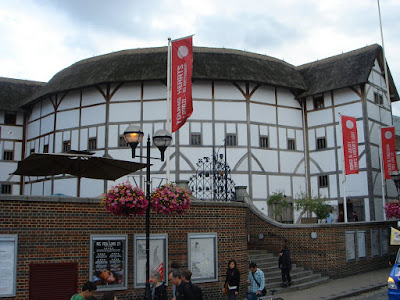
Shakespeare's original Globe Theater was destroyed in 1642. In 1997, a replica was built 750 ft. away from the original theater. Every summer plays are held in the building. I wanted to go inside or at least get close to check it out, but the entire theater was surrounded by gates. There was a line outside the entrance, but I don't know if it was a line for a play or a line for a tour. Instead of waiting to find out, I continued walking around until I found St. Paul's Cathedral.

This is where Prince Charles married Lady Diana in 1981. Anyway, that concluded my day. After a lot of shopping and walking around, I was exhausted and looking forward to just calling it a night.
This outside area is devoted to street performers. Early in the morning it wasn't very crowded at all. The weather wasn't very cooperative either, so that may have influenced the absence of entertainers. Inside the building on the left are stalls where local businesses sell their goods, ranging from glassware, ceramics, jewelry, hats, clothes, and random knickknacks. It's essentially a glorified farmer's market, some things were rather expensive (as in >100 euros).
Eventually I made my way to two of the most popular shopping streets in all of London. The picture above is on Regent street. This street is filled with fancy shops and upscale department stores. It also had the biggest Apple store I've ever seen. I forgot to take a picture of it unfortunately, but it was two stories with about 80% of the store empty with only small tables along the perimeter. Fairly typical of any other Apple store, lots of wasted space.
The picture below was taken on Oxford street. It's a road practically 1 mile long filled with stores and department stores on either side. Unlike Regent street, the stores along this area were much more affordable.
I honestly spent almost the entire day just shopping around and I don't have very many pictures chronicling my shopping spree.
Fast forward a couple hours, I went back to the south eastern part of London and made a stop at the Globe Theater.
Shakespeare's original Globe Theater was destroyed in 1642. In 1997, a replica was built 750 ft. away from the original theater. Every summer plays are held in the building. I wanted to go inside or at least get close to check it out, but the entire theater was surrounded by gates. There was a line outside the entrance, but I don't know if it was a line for a play or a line for a tour. Instead of waiting to find out, I continued walking around until I found St. Paul's Cathedral.
This is where Prince Charles married Lady Diana in 1981. Anyway, that concluded my day. After a lot of shopping and walking around, I was exhausted and looking forward to just calling it a night.
Thursday, July 30, 2009
You sound like you're from LON-DON!
In the event the title of this post may seem familiar, it's from the movie Forgetting Sarah Marshall, when Paul Rudd's forgetful character approaches an injured Londoner calling for help.
Anyway, Friday, July 17 I left for London. There are direct trains to London leaving from Brussels, the only requirement is that you have to check into the train station a half hour before the train is scheduled to depart. Once the train gets to the coast, it passes through a chunnel to get to the UK. Unlike all the other countries I've visited so far, I had to through customs in order to get to the UK. This process was essentially the same thing you see on international flights, you go through a passport check and then declare any goods that you bought.
The train ride from Brussels to London only took about 2 hours. A high-speed train rides this route and there are very few stops, so this contributes to the short commute between the cities. I arrived in London fairly late in the evening. As a result, I didn't have much time to explore. I first made my way to my hostel so that I could drop off my duffel bag. I forgot to mention that in order to get to the hostel, I had to use the metro, which they apparently call the 'tube.' Similar to what I mentioned about the metro in Paris, the 'tube' here in London works just like any other major city (not surprisingly). You can buy individual one-way tickets or you can purchase a card and deposit money onto it as you go. I opted to purchase the card since that also gives me a nice souvenir to take home.


This is the hostel I stayed at. I forgot to take a picture for myself, so I grabbed this off of google images. This hostel was advertised as a "party hostel," partly due to the fact that a bar is directly attached to the hostel and there's a back door (without a bouncer) into the bar. Another reason is because you probably won't be getting a good night's sleep unless you're intoxicated. As such, I didn't get much sleep here. The environment was fun though, receptionists were friendly, fellow hostelers were nice and easy to get along with. I met people from Canada, Australia, France, Denmark and the UK.
Since I got into London late on the first night, I decided to just walk around the area. Within close proximity of the hostel were the Tower of London Bridge and the Tower of London.
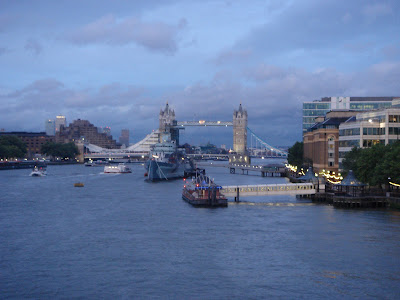
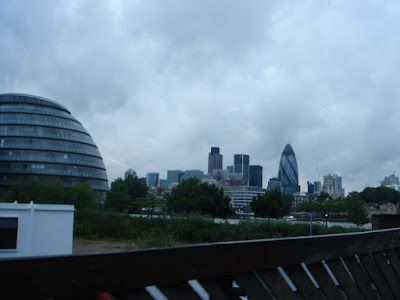
On the right of this photograph, you can see a conical-like building. I was just reading an article the other day about the world's 18 strangest buildings and that cone building claims a spot on that list. It's called the Gherken and is the second tallest building in London.
After walking around the area I decided to call it a night. I dedicated the following day entirely to sight-seeing. My first stop was Big Ben and the Parliament houses.
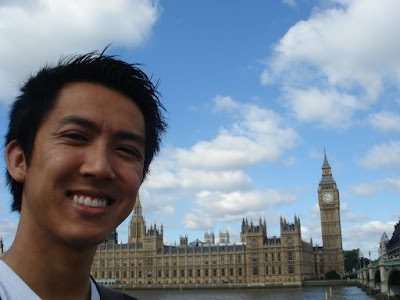
As expected, the neo-gothic building is much more majestic in person. The 150th anniversary of the bell tower was celebrated just this past May. On the right is Westminster Bridge.
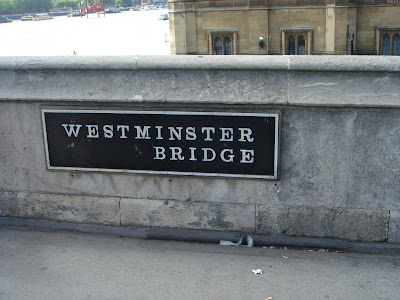

Along the River Thames and next to Westminster Bridge, there's the London Eye and an aquarium. The London Eye is 443 ft high and is the tallest Ferris wheel in all of Europe. As opposed to the ferris wheels you find at local carnivals, this ferris wheel has 32 pods that are shaped sort of like jelly beans and are completely sealed and air conditioned.
After walking around a little bit more, I made my way to Buckingham Palace for the changing of the guard. First of all, the crowd outside the palace was fantastically enormous.
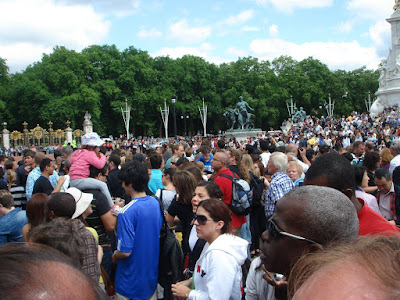
Tour buses lined the perimeter of the palace and every direction I looked I could see a tour guide holding up some sort of object (umbrella or sign usually) and a large group (usually consisting of Asians wearing headphones) marching behind them.
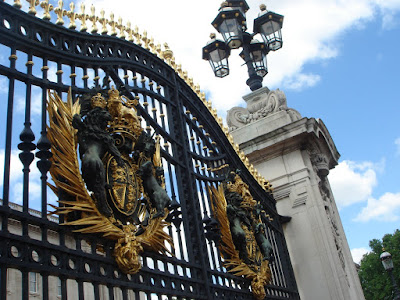

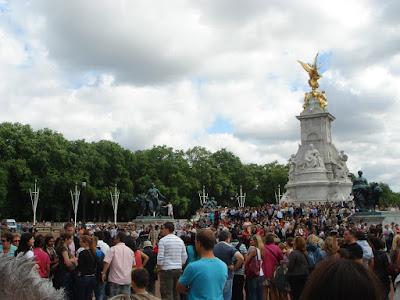
 I got to Buckingham Palace early enough to catch the Changing of the Guard ceremony. My tour book made statements about how it's overrated, but I wanted to see it anyway. After an hour of waiting outside the gates, two bands marched into the palace coming from two different directions. They then took turns playing songs. I didn't even notice that the guards in front of the palace even switched out since too much focus was centered around the bands.
I got to Buckingham Palace early enough to catch the Changing of the Guard ceremony. My tour book made statements about how it's overrated, but I wanted to see it anyway. After an hour of waiting outside the gates, two bands marched into the palace coming from two different directions. They then took turns playing songs. I didn't even notice that the guards in front of the palace even switched out since too much focus was centered around the bands.
Here are some random pictures I took while walking around the city looking for a place to have lunch.
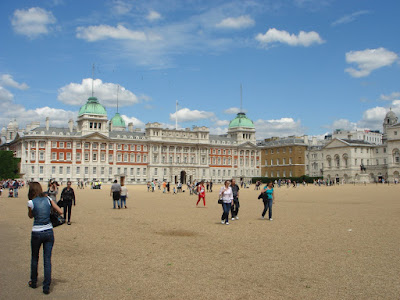

For a late lunch, I stopped at a place called Porter's where I got a meat pie.
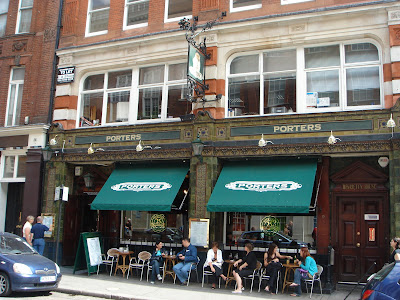
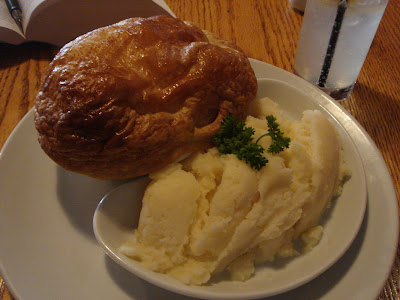
While I was in the UK, I figured I would try the traditional food. Anyway, the meat pie was filled with steak and mushrooms and doused in a salty sauce made from Guinness beer.
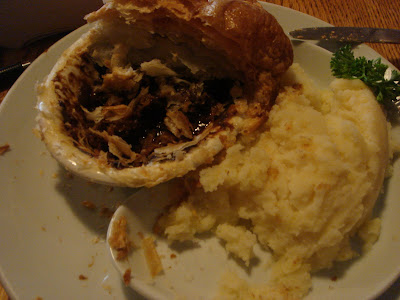
Eventually I finished it, but it did take almost 45 minutes. The meat pie wasn't what I was expecting. When I first saw it, I thought that the crust would be doughy, however that was definitely not the case. Instead, it was flaky, like a croissant. At first I wasn't too excited about having a pie for lunch, especially one filled with meat. Like most people I associate pie with dessert, so my mind was stuck at a crossroad trying to figure out what to expect. It was delicious though and I finished the entree fully satiated.
For dessert, I got a spotted dick.

It's a spongy and sweet cake topped with custard and stuffed with dried fruit. For those who frequent Asian dim sums for brunch, the texture and taste of the spotted dick reminded me of ma lai gao, the spongy yellow cake that you'll usually find on the dessert cart at dim sum. For those who don't have experience with dim sum, ma lai gao is a traditional Chinese steamed cake. It's spongy, yellow, and has a light sweet taste.

After filling my stomach, I then found my way into Trafalgar Square, the most recognized square in the UK, and some argue, the world. The building on the left is the National Gallery, which houses a vast assortment of artists. Here they have Van Gogh's Sunflowers, Van Gogh's Chair, Two Crabs, and A Wheatfield with Cypresses. It also houses works from Michelangelo, Rubens, Titian, and da Vinci. Sorry for the lack of photos, once again photography was adamantly prohibited. Museum workers were stationed in every room and chased down anyone taking pictures.
By the time I left the museum, evening had already begun to set in. I hung out outside Trafalgar Square for a little bit, just adsorbing the opportunity and coming to the realization that I'm in London! Eventually I made my way back to the area where my hostel was located. I wandered around a little bit and walked around the Tower of London.

Several noticeable figures of history that were imprisoned here include Ann Boleyn and Sir Walter Raleigh. For the rest of the night I went back to the hostel and chatted with some of the other guests.
Anyway, Friday, July 17 I left for London. There are direct trains to London leaving from Brussels, the only requirement is that you have to check into the train station a half hour before the train is scheduled to depart. Once the train gets to the coast, it passes through a chunnel to get to the UK. Unlike all the other countries I've visited so far, I had to through customs in order to get to the UK. This process was essentially the same thing you see on international flights, you go through a passport check and then declare any goods that you bought.
The train ride from Brussels to London only took about 2 hours. A high-speed train rides this route and there are very few stops, so this contributes to the short commute between the cities. I arrived in London fairly late in the evening. As a result, I didn't have much time to explore. I first made my way to my hostel so that I could drop off my duffel bag. I forgot to mention that in order to get to the hostel, I had to use the metro, which they apparently call the 'tube.' Similar to what I mentioned about the metro in Paris, the 'tube' here in London works just like any other major city (not surprisingly). You can buy individual one-way tickets or you can purchase a card and deposit money onto it as you go. I opted to purchase the card since that also gives me a nice souvenir to take home.

This is the hostel I stayed at. I forgot to take a picture for myself, so I grabbed this off of google images. This hostel was advertised as a "party hostel," partly due to the fact that a bar is directly attached to the hostel and there's a back door (without a bouncer) into the bar. Another reason is because you probably won't be getting a good night's sleep unless you're intoxicated. As such, I didn't get much sleep here. The environment was fun though, receptionists were friendly, fellow hostelers were nice and easy to get along with. I met people from Canada, Australia, France, Denmark and the UK.
Since I got into London late on the first night, I decided to just walk around the area. Within close proximity of the hostel were the Tower of London Bridge and the Tower of London.
On the right of this photograph, you can see a conical-like building. I was just reading an article the other day about the world's 18 strangest buildings and that cone building claims a spot on that list. It's called the Gherken and is the second tallest building in London.
After walking around the area I decided to call it a night. I dedicated the following day entirely to sight-seeing. My first stop was Big Ben and the Parliament houses.
As expected, the neo-gothic building is much more majestic in person. The 150th anniversary of the bell tower was celebrated just this past May. On the right is Westminster Bridge.
Along the River Thames and next to Westminster Bridge, there's the London Eye and an aquarium. The London Eye is 443 ft high and is the tallest Ferris wheel in all of Europe. As opposed to the ferris wheels you find at local carnivals, this ferris wheel has 32 pods that are shaped sort of like jelly beans and are completely sealed and air conditioned.
After walking around a little bit more, I made my way to Buckingham Palace for the changing of the guard. First of all, the crowd outside the palace was fantastically enormous.
Tour buses lined the perimeter of the palace and every direction I looked I could see a tour guide holding up some sort of object (umbrella or sign usually) and a large group (usually consisting of Asians wearing headphones) marching behind them.
Here are some random pictures I took while walking around the city looking for a place to have lunch.
For a late lunch, I stopped at a place called Porter's where I got a meat pie.
While I was in the UK, I figured I would try the traditional food. Anyway, the meat pie was filled with steak and mushrooms and doused in a salty sauce made from Guinness beer.
Eventually I finished it, but it did take almost 45 minutes. The meat pie wasn't what I was expecting. When I first saw it, I thought that the crust would be doughy, however that was definitely not the case. Instead, it was flaky, like a croissant. At first I wasn't too excited about having a pie for lunch, especially one filled with meat. Like most people I associate pie with dessert, so my mind was stuck at a crossroad trying to figure out what to expect. It was delicious though and I finished the entree fully satiated.
For dessert, I got a spotted dick.
It's a spongy and sweet cake topped with custard and stuffed with dried fruit. For those who frequent Asian dim sums for brunch, the texture and taste of the spotted dick reminded me of ma lai gao, the spongy yellow cake that you'll usually find on the dessert cart at dim sum. For those who don't have experience with dim sum, ma lai gao is a traditional Chinese steamed cake. It's spongy, yellow, and has a light sweet taste.
After filling my stomach, I then found my way into Trafalgar Square, the most recognized square in the UK, and some argue, the world. The building on the left is the National Gallery, which houses a vast assortment of artists. Here they have Van Gogh's Sunflowers, Van Gogh's Chair, Two Crabs, and A Wheatfield with Cypresses. It also houses works from Michelangelo, Rubens, Titian, and da Vinci. Sorry for the lack of photos, once again photography was adamantly prohibited. Museum workers were stationed in every room and chased down anyone taking pictures.
By the time I left the museum, evening had already begun to set in. I hung out outside Trafalgar Square for a little bit, just adsorbing the opportunity and coming to the realization that I'm in London! Eventually I made my way back to the area where my hostel was located. I wandered around a little bit and walked around the Tower of London.
Several noticeable figures of history that were imprisoned here include Ann Boleyn and Sir Walter Raleigh. For the rest of the night I went back to the hostel and chatted with some of the other guests.
Relaxing in Leuven
During the week after I got back from Paris, my dad made a quick visit to Leuven before the end of his business trip. Two nights during the week we met up after work for dinner and a beer in the city center of Leuven.
On the first night, we went to Oude Markt (Old Market), which is the pedestrianized square filled with bars and restaurants along the perimeter.
The first night we went to a place called The Meating Room. It's a steak restaurant situated right in Oude Markt. The menu was littered with all different types and cuts of steak. I'm no steak aficionado, so I randomly chose one off the menu.

The fries were complementary with the meal. I recently discovered that the reason why Belgium's fries are unique is because they are fried twice. The first dose is to cook them while the second is used to brown them.
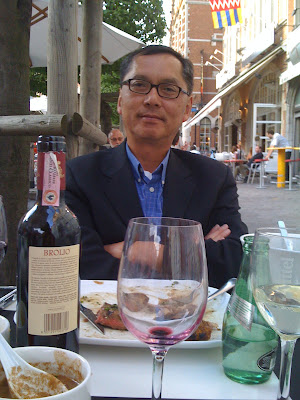
My dad couldn't finish his steak. Not quite sure why he's proud of that...
For dessert, we got some vanilla ice cream with raspberry topping.

I forgot to take a picture of it before we started to devour it. My bad.
The next night, we went to a restaurant right on the main shopping street in Leuven. Right after you sit down, they give you a complementary appetizer.
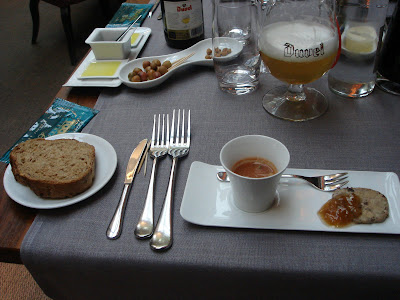
The small slice on the right is foie gras and the cup on the left was a cold soup. For an appetizer, we got grilled king crab. First of all, I've never had grilled crab before, so that was new. Secondly, the crab was by no means 'king.'
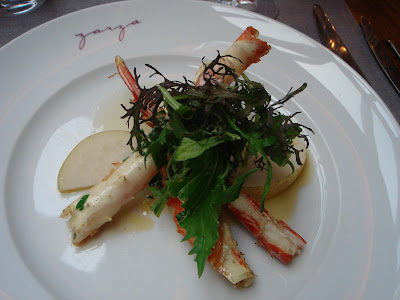
For the main entree, I got a lamb rack. I just noticed that I tend to pick lamb a lot during my meals. I think next time I go out I'll stay away from it.

For dessert, we got a strawberry dish.
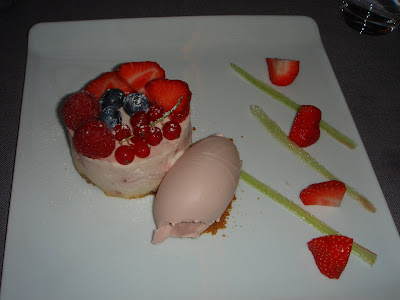
On the right is a scoop of strawberry sorbet. On the left, there's a really dense yogurt-like mass of strawberry. I actually wasn't a fan of this dish. The yogurt-like substance tasted a little bitter and there was something inside the mound that conflicted with the texture of the yogurt.
Anyway, that concluded our dinners in Leuven.
On the first night, we went to Oude Markt (Old Market), which is the pedestrianized square filled with bars and restaurants along the perimeter.
The first night we went to a place called The Meating Room. It's a steak restaurant situated right in Oude Markt. The menu was littered with all different types and cuts of steak. I'm no steak aficionado, so I randomly chose one off the menu.
The fries were complementary with the meal. I recently discovered that the reason why Belgium's fries are unique is because they are fried twice. The first dose is to cook them while the second is used to brown them.
My dad couldn't finish his steak. Not quite sure why he's proud of that...
For dessert, we got some vanilla ice cream with raspberry topping.
I forgot to take a picture of it before we started to devour it. My bad.
The next night, we went to a restaurant right on the main shopping street in Leuven. Right after you sit down, they give you a complementary appetizer.
The small slice on the right is foie gras and the cup on the left was a cold soup. For an appetizer, we got grilled king crab. First of all, I've never had grilled crab before, so that was new. Secondly, the crab was by no means 'king.'
For the main entree, I got a lamb rack. I just noticed that I tend to pick lamb a lot during my meals. I think next time I go out I'll stay away from it.
For dessert, we got a strawberry dish.
On the right is a scoop of strawberry sorbet. On the left, there's a really dense yogurt-like mass of strawberry. I actually wasn't a fan of this dish. The yogurt-like substance tasted a little bitter and there was something inside the mound that conflicted with the texture of the yogurt.
Anyway, that concluded our dinners in Leuven.
Sunday, July 26, 2009
Paris Day 3!
The Sunday of that weekend was my last day in Paris. My train was leaving around 8 pm, so I had most of the day to explore with my dad. The morning was a little overcast as you can see from the image below.

For today, my dad and I decided to dedicate most of our day to exploring the Louvre. From our hotel, we walked over to the museum. The trek only took about half an hour.

Right in front of the Louvre, there's a small arch. In the background you can see the glass pyramid. Unsurprisingly the Louvre is the most visited museum in the world. The museum is composed of 3 separate wings that house over 35,000 objects ranging from 6th century BC to the 19th century. In total, the floor plan spans about 652,300 square feet. It is impossible to see everything in the museum. I imagine you could spend a week here and still not see everything.
The museum was absolutely packed with tour groups from all over the world.

It's interesting to note that the entrances to each wing are centered around the glass pyramid.

In the above image you see the glass pyramid from the inside. Stairs lead you below ground level and then on three edges of the square pyramid are the entrances to the exhibits.
Since there are such vast collections of antiquities at the Louvre, I'll only mention the major pieces that we saw.
The first major piece we ran into was the Venus de Milo.

The original spot where the sculpture was stored is undergoing renovation, so it was temporarily placed in a small hallway. As a result, the crowd in front of the statue was massively large. We essentially had to wait and push our way through to the front to take pictures. Anyway, this marble sculpture spans 6'8" and was sculpted sometime between 130 and 100 BC. The mystery of the statue is derived from her missing arms, which were lost along with the original stage on which the statue stood.
Our next stop was Winged Victory. The pathway to the statue was surprisingly majestic. A staircase rises up past an arch and focuses solely on this piece.

I know the picture is pretty blurry. The museum in general was a little dark and my camera had a hard time focusing. I think you can get the idea though.

While my dad and I were admiring the sculpture, museum workers actually cleared out the entire area of people. They made everyone move into the 2nd room away from the statue so that the area was absolutely clear down to the stairs before Winged Victory. I wasn't quite sure of the reason for this but my dad hypothesized that they need to do this in order to clear the area of lingering people so that the crowd can continue to move. Makes sense to me I guess.
On the way to see the Mona Lisa, we ran into this rather morbid painting.

There's a cleaver sliced half way into the man's head...
Anyway, we finally made our way into the room that features Leonardo da Vinci's Mona Lisa. I suspect it's the most famous painting in the world, but I'm guessing others may beg to differ based on preference. Oh well, to each their own.

The painting was in the least optimum environment to capture a good photograph. First of all, there's a barricade that circles the painting that prevents people from getting within 10 feet of it. Secondly, it's enclosed in a a glass casing, making flash photography/red-eye prevention flashes reflect off the surface. Lastly, there's an eager mob of probably 50 people all shoving their way closer to the barricade, pushing people out their way and jabbing shoulders with cameras trying to capture the perfect angle. I was practically sweating by the time I got to the front of the crowd since the museum was so hot and everyone was packed in like sardines.

From the picture above you can see that it's true what people say about the painting being surprisingly small.
Afterwards we then found the Dying Slave sculpted by Michelangelo between 1513 and 1516.

I'm assuming the back side of the sculpture was nude based on the kid's surprised response on the left.
There was also a large sculpture garden nearby.

We also saw the stone on which Hammurabi's Code is inscribed.

The code dates back to about 1790 BC. It's quite miraculous to be standing next to such history.
In the Egyptian antiquities section there's a sitting statue of Ramses.

I touched this one too!

There were also a couple sphinxes.
After walking around the museum for hours, my dad and I decided to stop at the museum restaurant for a late lunch. The food was surprisingly cheap considering it was a museum restaurant. It was also quite good.
I got a steak with potatoes.

For dessert, I got a spongy cake filled with custard and fresh strawberries.

We walked around the museum a little bit more afterwards. We already hit all the major pieces, so I'm not going to elaborate on the rest of the antiquities that we saw. When we left, we just took some more pictures outside the glass pyramid.

Visiting the Louvre pretty much took all day. We didn't even get close to seeing everything, however, we were able to hit all the major pieces that we were aware of. Obviously if you ever go to Paris, the Louvre is a must see. Set aside at least an entire day to see the museum at a leisurely pace. You can see the big three (Venus de Milo, Mona Lisa, and Winged Victory) in maybe 1.5 hours if you rush, however it's much more pleasurable to take your time as you stroll through this gargantuan museum.
Sadly, the visit to the Louvre concluded my visit to Paris. I'm trying to make plans to go back in the next coming weeks, so hopefully that plan gets finalized.
For today, my dad and I decided to dedicate most of our day to exploring the Louvre. From our hotel, we walked over to the museum. The trek only took about half an hour.
Right in front of the Louvre, there's a small arch. In the background you can see the glass pyramid. Unsurprisingly the Louvre is the most visited museum in the world. The museum is composed of 3 separate wings that house over 35,000 objects ranging from 6th century BC to the 19th century. In total, the floor plan spans about 652,300 square feet. It is impossible to see everything in the museum. I imagine you could spend a week here and still not see everything.
The museum was absolutely packed with tour groups from all over the world.
It's interesting to note that the entrances to each wing are centered around the glass pyramid.
In the above image you see the glass pyramid from the inside. Stairs lead you below ground level and then on three edges of the square pyramid are the entrances to the exhibits.
Since there are such vast collections of antiquities at the Louvre, I'll only mention the major pieces that we saw.
The first major piece we ran into was the Venus de Milo.
The original spot where the sculpture was stored is undergoing renovation, so it was temporarily placed in a small hallway. As a result, the crowd in front of the statue was massively large. We essentially had to wait and push our way through to the front to take pictures. Anyway, this marble sculpture spans 6'8" and was sculpted sometime between 130 and 100 BC. The mystery of the statue is derived from her missing arms, which were lost along with the original stage on which the statue stood.
Our next stop was Winged Victory. The pathway to the statue was surprisingly majestic. A staircase rises up past an arch and focuses solely on this piece.
I know the picture is pretty blurry. The museum in general was a little dark and my camera had a hard time focusing. I think you can get the idea though.
While my dad and I were admiring the sculpture, museum workers actually cleared out the entire area of people. They made everyone move into the 2nd room away from the statue so that the area was absolutely clear down to the stairs before Winged Victory. I wasn't quite sure of the reason for this but my dad hypothesized that they need to do this in order to clear the area of lingering people so that the crowd can continue to move. Makes sense to me I guess.
On the way to see the Mona Lisa, we ran into this rather morbid painting.
There's a cleaver sliced half way into the man's head...
Anyway, we finally made our way into the room that features Leonardo da Vinci's Mona Lisa. I suspect it's the most famous painting in the world, but I'm guessing others may beg to differ based on preference. Oh well, to each their own.
The painting was in the least optimum environment to capture a good photograph. First of all, there's a barricade that circles the painting that prevents people from getting within 10 feet of it. Secondly, it's enclosed in a a glass casing, making flash photography/red-eye prevention flashes reflect off the surface. Lastly, there's an eager mob of probably 50 people all shoving their way closer to the barricade, pushing people out their way and jabbing shoulders with cameras trying to capture the perfect angle. I was practically sweating by the time I got to the front of the crowd since the museum was so hot and everyone was packed in like sardines.
From the picture above you can see that it's true what people say about the painting being surprisingly small.
Afterwards we then found the Dying Slave sculpted by Michelangelo between 1513 and 1516.
I'm assuming the back side of the sculpture was nude based on the kid's surprised response on the left.
There was also a large sculpture garden nearby.
We also saw the stone on which Hammurabi's Code is inscribed.
The code dates back to about 1790 BC. It's quite miraculous to be standing next to such history.
In the Egyptian antiquities section there's a sitting statue of Ramses.
I touched this one too!
There were also a couple sphinxes.
After walking around the museum for hours, my dad and I decided to stop at the museum restaurant for a late lunch. The food was surprisingly cheap considering it was a museum restaurant. It was also quite good.
I got a steak with potatoes.
For dessert, I got a spongy cake filled with custard and fresh strawberries.
We walked around the museum a little bit more afterwards. We already hit all the major pieces, so I'm not going to elaborate on the rest of the antiquities that we saw. When we left, we just took some more pictures outside the glass pyramid.
Visiting the Louvre pretty much took all day. We didn't even get close to seeing everything, however, we were able to hit all the major pieces that we were aware of. Obviously if you ever go to Paris, the Louvre is a must see. Set aside at least an entire day to see the museum at a leisurely pace. You can see the big three (Venus de Milo, Mona Lisa, and Winged Victory) in maybe 1.5 hours if you rush, however it's much more pleasurable to take your time as you stroll through this gargantuan museum.
Sadly, the visit to the Louvre concluded my visit to Paris. I'm trying to make plans to go back in the next coming weeks, so hopefully that plan gets finalized.
Subscribe to:
Posts (Atom)